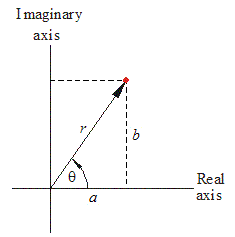A complex number #z# is of the form
#z=a+bi#
We define the Polar coordinates of #z# to be #(r,theta)#, as seen in the image below.

From this diagram we get some more properties:
#r=sqrt(a^2+b^2)#
#sin theta = b/r => b=rsintheta#
#costheta=a/r =>a=rcostheta#
If we substitute #b# and #a# into the definition of a complex number, we have
#z=rcostheta+irsintheta = r(costheta+isintheta)#
Our trigonometric sum resembles #color(red)("Euler's identity")#:
#e^(icolor(red)alpha)=coscolor(red)alpha+isincolor(Red)(alpha#
Thus,
#z=re^(itheta)#
In our case, it'd be easier to write them in this exponential form then transform it into trigonometric form.
Let #color(blue)(z_1 = -i+1# and #color(blue)(z_2 = 2i+10#.
We do not need to find #theta_1# and #theta_2# now, so we will let them as that.
#r_1 = sqrt(a_1^2+b_1^2) = sqrt(1^2+(-1)^2) = sqrt2#
#r_2 = sqrt(a_2^2+b_2^2)=sqrt(100+4)=sqrt(104)=2sqrt(26)#
#:. z_1/z_2=(r_1e^(itheta_1))/(r_2e^(itheta_2))#
#z_1/z_2 = sqrt2/(2sqrt26) * e^(i(theta_1-theta_2)#
#z_1/z_2 = 1/(2sqrt13) * e^(i(theta_1-theta_2)#
We can still apply Euler's identity to #e^(i(theta_1-theta_2))#. We have:
#e^(i(theta_1-theta_2)) = cos(theta_1-theta_2)+isin(theta_1-theta_2)#
The #color(blue)("Difference formula")# for cosine and sine is, as follows:
#cos(a-b)=cosacosb+sinasinb#
#sin(a-b) = sinacosb-cosasinb#
#cos(theta_1 - theta_2) = costheta_1costheta_2+sintheta_1sintheta_2#
#sin(theta_1-theta_2) = sintheta_1costheta_2-costheta_1sintheta_2#
From the properties we got earlier, we know:
#costheta_1 = 1/sqrt2#
#sintheta_1 = -1/sqrt2#
#costheta_2 = 5/sqrt26#
#sintheta_2=1/sqrt26#
After we calculate the values we needed, we reach this:
#cos(theta_1-theta_2) = 2/sqrt13#
#sin(theta_1-theta_2)= -3/sqrt13#
Finally, we get:
#z_1/z_2 = 1/(2sqrt13) (2/sqrt13 -i3/sqrt13)#
#z_1/z_2 = 1/2(2/13 - i3/13)#
#:.#
#(-i+1)/(2i+10) =1/2(2/13 - i3/13)#


